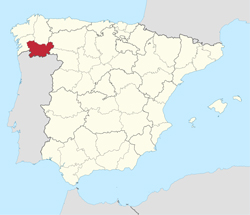Orense in Orense

 The province of Orense is situated in the south west of the region of Galicia in northwestern Spain.It borders on the provinces of Pontevedra, Lugo, León and Zamora; and to the south it neighbours Portugal.
The province of Orense is situated in the south west of the region of Galicia in northwestern Spain.It borders on the provinces of Pontevedra, Lugo, León and Zamora; and to the south it neighbours Portugal.
Orense has a surface of 7,273 km2, and it is the only Galician province without a coastline.
It is a very mountainous province, although in the western part the mountain peaks rarely surpass a height of 1,000 m. The peaks are higher in the central-eastern part, and in the mountain ranges that constitute the borders to León and Zamora the peaks are often more than 2,000 metres high.
The highest point in Orense is Peña Trevinca at 2,127 m.
Where there are mountains and mountain ranges there are also valleys and rivers, and Orense has a wealth of both.
There are three main catchment areas belonging to the large rivers of Miño, Limio and Duero respectively; where these three main rivers and their many smaller, though still important, tributaries make their way through the mountains toward the valleys they have created some of Orense’s most beautiful natural sights and spectacular waterfalls.
The province of Orense has 309,293 inhabitants, more than a third of whom – 105,233 – live in the capital of the same name, which is situated in the north west of the province. It is traversed by three rivers: Miño, Barbaña and Lonia.
Orense is home to several natural thermal spas, and for this reason there have been human settlements in the area ever since the late Bronze Age.
But the actual city was founded by the Romans. At the time, there was an abundance of gold to be found in the river Miño, and this turned Orense into one of the most important provinces of Roman Hispania. A theory behind the name of the city is that it has been derived from the Latin ‘Auriense’, referring to ‘The City of Gold’.
The Romans constructed a bridge over the river Miño which has been reconstructed countless times over the centuries; it is known as Ponte Romana, Ponte Vella and Puente Mayor, and it is still an integral part of the infrastructure of Orense – and it still rests on its Roman foundations.
In the nature of its geographical situation, Orense has always been on the periphery of history, but it does have a few claims to fame from the middle ages: It was occupied by the Duke of Lancaster who proclaimed himself King of Castile in Orense; it was central to the second Irmandiño revolt; and Cardinal Cisnero received Juana la Loca and Philip the Handsome in the city and managed to calm the waters and persuade them to rule side by side with Juana’s father, Fernando el Católico, as laid out in the last will and testament of her mother, Isabel la Católica.
The city lived through a long dull period over the 17th and 18th centuries, and at the beginning of the 19th century Orense was a small city mainly populated by hidalgos, artisans and clergy.
But the city’s ascend to the status of provincial capital combined with the event of a railway line connecting it to Vigo turned the city’s fortune and saw the birth of a new bourgeoisie; immigration to the city from the rural areas caused a building boom and the industry and construction sectors grew and consolidated.
Today Orense is an administrative centre with a strong commercial sector, connected to the rest of Spain through railways and motorways, with easy access from all directions.
The city is generating an important tourist industry, to a great extent centred round the many thermal spa and bath venues.
Other places worth seeing in Orense include the Millennium Bridge, a modern construction next one down from the Ponte Romano; it has a stunning avant garde design with a pedestrian walkway whose highest point is 22 meters and which then dips down far below the level of the carriageway.
‘As Burgas’ are hot springs in the historic center of Orense. They include Burga do Medio, which is infused with gas, Burga de Arriba and a Burga de Abaixo. The waters are similar to those of Carlsbad, and gush from granite rock to the west of the town, almost at boiling point. The hot mineral waters gush at 80 gallons per minute.
Furthermore, the cathedral, Plaza de San Francisco, the historic centre and many more monuments and sights attract thousands of visitors every year.


